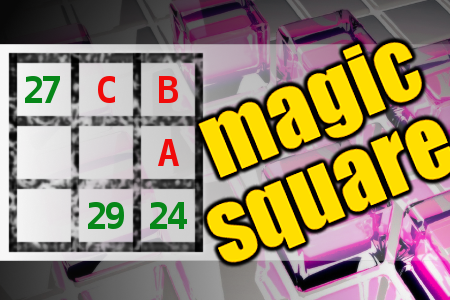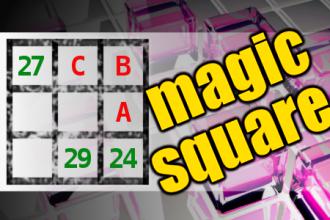MAGIC SQUARE: Calculate A*B-C
The aim is to place the some numbers from the list (15, 16, 17, 24, 25, 26, 27, 28, 29, 53) into the empty squares and squares marked with A, B an C. Sum of each row and column should be equal. All the numbers of the magic square must be different. Find values for A, B, and C. Solution is A*B-C.
It's great to be a guy
Reasons why it's great to be a guy
Phone conversations are over in 30 seconds flat.
You know stuff about tanks.
A five day vacation requires only one suitcase.
Monday Night Football.
Your bathroom lines are 80% shorter.
You can open all your own jars.
Old friends don't annoy you if you've lost or gained weight.
Dry cleaners and haircutters don't rob you blind.
When clicking through the channel, you don't have to stall on every shot of someone crying.
A beer gut does not make you invisible to the opposite sex.
Guys in hockey masks don't attack you.
You don't have to lug a bag of useful stuff around everywhere you go.
You can go to the bathroom without a support group.
Your last name stays put.
You can leave a hotel bed unmade.
When your work is criticized, you don't have to panic that everyone secretly hates you.
You can kill your own food.
The garage is all yours.
You get extra credit for the slightest act of thoughtfulness.
You see the humor in Terms of Endearment.
You never have to clean the toilet.
You can be showered and ready in 10 minutes.
Wedding plans take care of themselves.
If someone forgets to invite you to something, he or she can still be your friend.
Your underwear is $10 for a three pack.
The National College Cheerleading Championship
None of your co-workers have the power to make you cry.
You don't have to shave below your neck.
If you're 34 and single nobody notices.
Everything on your face stays its original color.
Chocolate is just another snack.
You can be president.
You can quietly enjoy a car ride from the passenger seat.
Flowers fix everything.
You never have to worry about other people's feelings.
You can wear a white shirt to a water park.
Three pair of shoes are more than enough.
You can eat a banana in a hardware store.
You can say anything and not worry about what people think.
Michael Bolton doesn't live in your universe.
You can whip your shirt off on a hot day.
You don't have to clean your apartment if the meter reader is coming by.
Car mechanics tell you the truth.
You don't care if someone notices your new haircut.
You can watch a game in silence with your buddy for hours without even thinking: He must be mad at me.
You never misconstrue innocuous statements to mean your lover is about to leave you.
You get to jump up and slap stuff.
One mood, all the time.
You can admire Clint Eastwood without starving yourself to look like him.
You know at least 20 ways to open a beer bottle.
Same work....more pay.
Gray hair and wrinkles add character.
Wedding Dress $2000; Tux rental $100.
You don't care if someone is talking about you behind your back.
You don't mooch off others' desserts.
The remote is yours and yours alone.
People never glance at your chest when you're talking to them.
ESPN's sports center.
You can drop by to see a friend without bringing a little gift.
You have a normal and healthy relationship with your mother.
You needn't pretend you're "freshening up" to go to the bathroom.
If you don't call your buddy when you say you will, he won't tell your friends you've changed.
Someday you'll be a dirty old man.
If another guy shows up at the party in the same outfit, you might become lifelong buddies.
Princess Di's death was almost just another obituary.
If something mechanical didn't work, you can bash it with a hammer and throw it across the room.
New shoes don't cut, blister, or mangle your feet.
You don't have to remember everyone's birthdays and anniversaries.
Your pals can be trusted never to trap you with: "So... notice anything different?"
Baywatch
There is always a game on somewhere.

